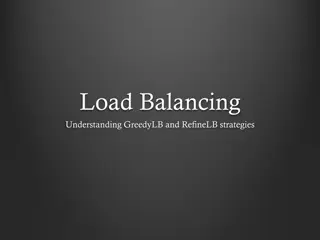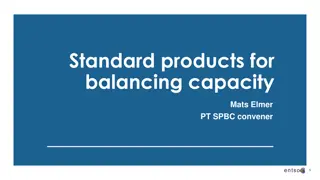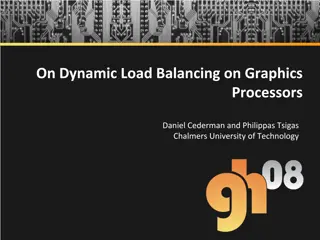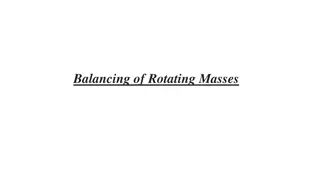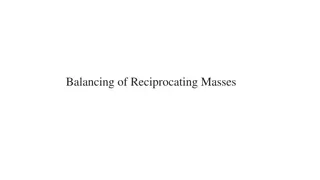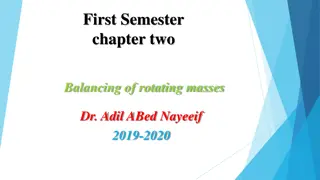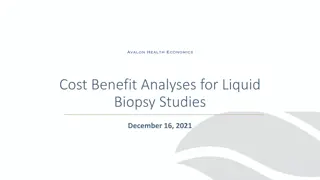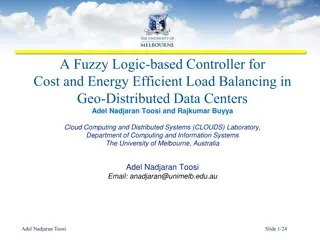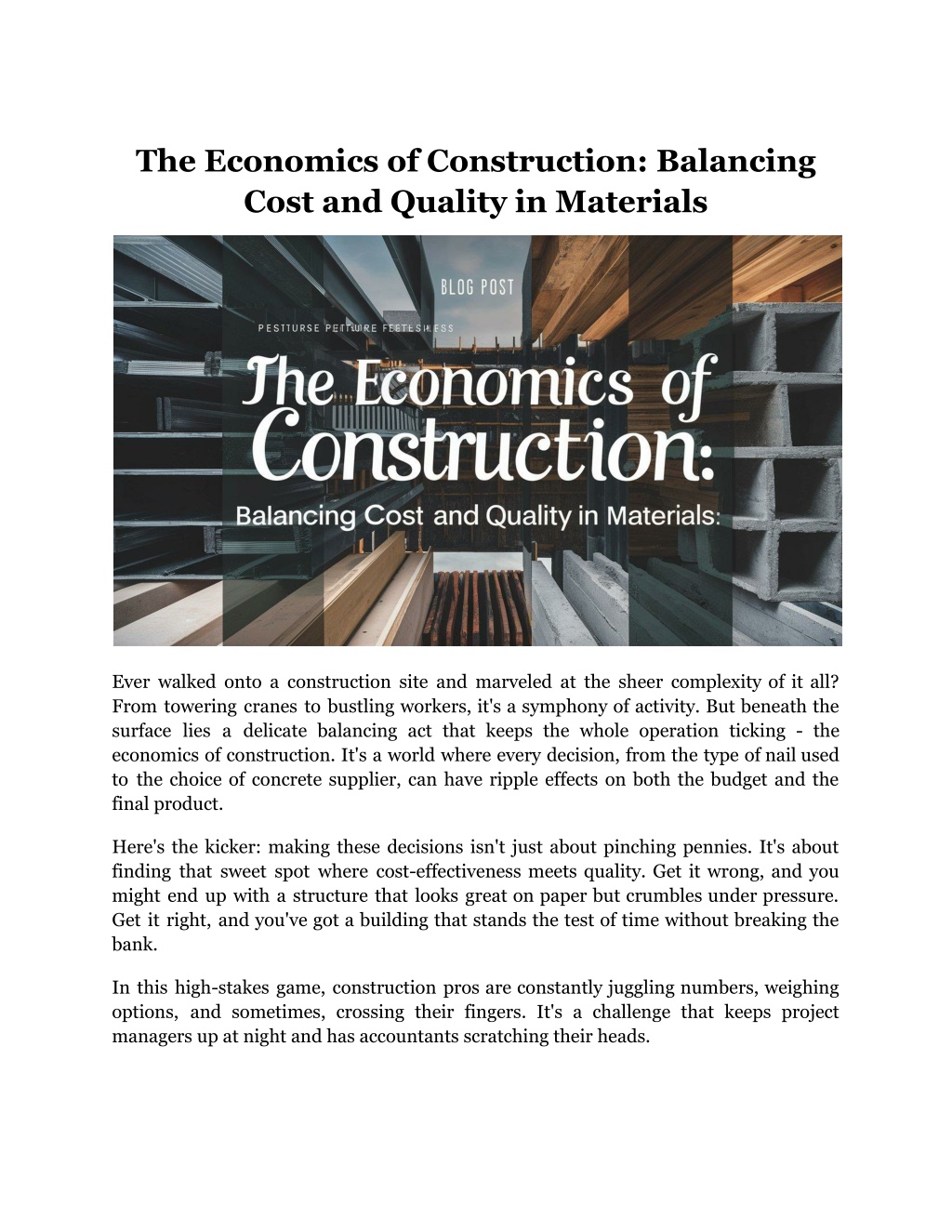
The Economics of Construction_ Balancing Cost and Quality in Materials
Discover how to strike the perfect balance between cost and quality when selecting construction materials.
Download Presentation

Please find below an Image/Link to download the presentation.
The content on the website is provided AS IS for your information and personal use only. It may not be sold, licensed, or shared on other websites without obtaining consent from the author. Download presentation by click this link. If you encounter any issues during the download, it is possible that the publisher has removed the file from their server.
E N D
Presentation Transcript
The Economics of Construction: Balancing Cost and Quality in Materials Ever walked onto a construction site and marveled at the sheer complexity of it all? From towering cranes to bustling workers, it's a symphony of activity. But beneath the surface lies a delicate balancing act that keeps the whole operation ticking - the economics of construction. It's a world where every decision, from the type of nail used to the choice of concrete supplier, can have ripple effects on both the budget and the final product. Here's the kicker: making these decisions isn't just about pinching pennies. It's about finding that sweet spot where cost-effectiveness meets quality. Get it wrong, and you might end up with a structure that looks great on paper but crumbles under pressure. Get it right, and you've got a building that stands the test of time without breaking the bank. In this high-stakes game, construction pros are constantly juggling numbers, weighing options, and sometimes, crossing their fingers. It's a challenge that keeps project managers up at night and has accountants scratching their heads.
The Hidden Costs of Quality Let's talk about the elephant in the room - the cost of quality (COQ). It's not just about how much you shell out for premium materials. Oh no, it goes much deeper than that. Think of it like an iceberg - what you see above the surface is just the tip of a much larger mass lurking below. The Iceberg Model: More Than Meets the Eye You're looking at your project budget, and feeling pretty good about those numbers. But hold up! Those visible costs? They're just the beginning. Here's a breakdown that might make you rethink your calculations: Cost Type Description % Project Cost of Total Visible Costs Direct costs of rework and repairs ~12% Hidden Costs Indirect reputation damage) costs (lost productivity, delays, Can exceed visible costs Shocking, right? Those hidden costs can be a real budget-buster if you're not careful. Sure, the sticker price looked good, but the real cost of ownership? That's a whole different ballgame. Breaking Down the Cost of Quality Now, let's get into the nitty-gritty. The cost of quality isn't just one big lump sum. It's made up of several components: 1. Prevention costs: This is your ounce of prevention that's worth a pound of cure. It's all about planning and implementing quality control measures before problems arise. 2. Appraisal costs: Think inspections and testing. It's like taking your car for a check-up before a long road trip. 3. Internal failure costs: These are the oops moments caught before the project is delivered. Like realising you used the wrong type of screw - annoying, but fixable.
4. External failure costs: The big yikes. These are issues that pop up after the project is complete. Think of it as the construction equivalent of your car breaking down in the middle of nowhere. Here's the kicker: Studies show that failure costs alone can eat up over 12% of your total project costs. And that's just in building construction! Read More Articles: A Comprehensive Guide to Construction Supplies for DIY Enthusiasts Material Selection: A Balancing Act Now, let's talk materials. Choosing the right ones is important. Sure, you could go cheap, but do you really want to risk serving your guests a subpar dish? The Long Game: Initial vs. Lifecycle Costs Here's where things get interesting. It's tempting to go for the cheapest option upfront, but that's often a recipe for disaster. Smart builders think long-term. They consider: Initial purchase price (the sticker shock) Installation costs (because that bargain material might be a pain to work with) Maintenance requirements (aka the gift that keeps on giving... or taking) Expected lifespan (how long before you're back at square one?) Energy efficiency impacts (because those utility bills add up) Take LED lighting, for example. Sure, it might cost more upfront, but the long-term savings in energy and maintenance? That's where the real magic happens. The Stakeholder Shuffle Now, here's where it gets tricky. Different people on the project have different priorities: Contractors are all about availability, workability, and cost-effectiveness. They're in the trenches, after all. Clients are watching their wallets but (hopefully) thinking about the future too. Architects and engineers? They're dreaming big about performance and durability.
The Green Factor Sustainability isn't just a buzzword anymore. It's becoming a major player in material selection. Consider this: Bamboo is giving hardwoods a run for their money Recycled steel is turning trash into treasure Self-healing concrete might sound like sci-fi, but it's the real deal Sure, these options might cost more upfront, but they often pay off in the long run through energy savings, reduced maintenance, and even tax incentives. Strategies for Striking the Perfect Balance So, how do we juggle all these factors without dropping the ball? Here are some pro tips: Quality Management Systems: Your New Best Friend Implementing a solid quality management system helps: Develop clear quality standards (so everyone's on the same page) Implement robust quality control processes (catching problems before they snowball) Invest in prevention and appraisal (because an ounce of prevention is worth a pound of cure) Value Engineering: Work Smarter, Not Harder Value engineering is about finding clever ways to enhance quality or cut costs without sacrificing functionality. This might involve: Analysing alternative materials or construction methods Identifying and eliminating doorknobs) Optimising designs for efficiency unnecessary features (goodbye, gold-plated Embrace the Tech Revolution Technology in construction isn't just about looking cool (though it does). It's about improving quality and cost-effectiveness:
Building Information Modeling (BIM) can help spot design conflicts before they become real-world headaches Prefabrication and modular construction can boost quality control while trimming labor costs Advanced materials like self-healing concrete are turning science fiction into science fact Data In the age of big data, making decisions based on hunches is so last century. Use data analytics and cost modeling to: Project long-term economic impacts of material choices Learn from past projects to guide future decisions Read More Articles: How to Prepare Your Office for a Professional Cleaning Service in NYC? Conclusion Balancing cost and quality in construction isn't just an art - it's a science. It requires a holistic view that goes beyond the price tag, considering lifecycle costs, stakeholder needs, sustainability, and long-term performance. Remember, in the world of construction economics, the cheapest option isn't always the most cost-effective. It's about finding that sweet spot where quality and affordability meet. So the next time you're faced with a material decision, take a step back, consider the big picture, and make a choice that'll have future you (and your wallet) thanking you. Want a concrete supplier in London that understands the delicate balance between cost and quality? Pro-Mix Concrete incorporates state-of-the-art mixing technology and a commitment to sustainable practices. We deliver superior concrete solutions that stand the test of time. Don't compromise on your next project - choose Pro-Mix Concrete for the strength you can build on. Site Article: The Economics of Construction: Balancing Cost and Quality in Materials






